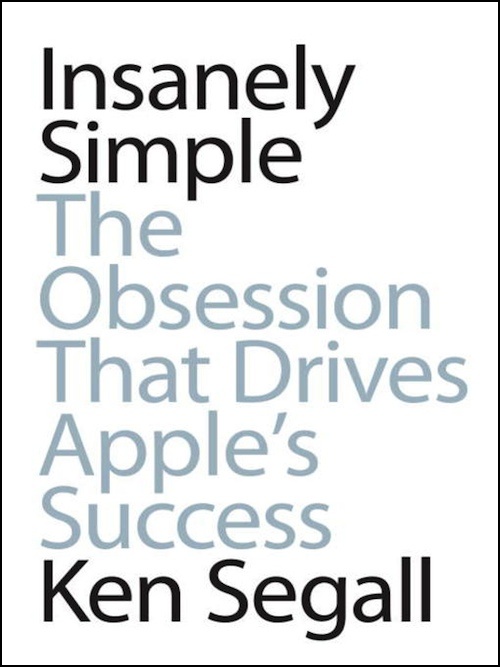Of all the books about Apple that have come out after Steve Jobs’s death, Ken Segall’s Insanely Simple: The Obsession That Drives Apple’s Success (published April, 2012) is the best I have read.1 Perhaps that is because the book’s theme is not Apple or Jobs per se. Insanely Simple is a business book that explains Apple’s phenomenal success with Steve Jobs’s passion for simplicity.
As creative director for the advertising agencies Steve Jobs chose for his companies – first, NeXT, and later, Apple – Ken Segall worked closely with Steve for more than a decade. Recounting his experiences with Apple as a company and Steve in particular, the author tries to uncover what makes Apple so successful and different than the competition. Segall breaks down everything from marketing over product design and operations to meeting culture and openness in communication into one aspect: a total obsession with simplicity.
To Steve Jobs, simplicity was a religion. It was also a weapon. Simplicity isn’t just a design principle at Apple – it’s a value that permeates every level of the organization. The obsession with Simplicity is what separates Apple from other technology companies. It’s what helped Apple recover from near death in 1997 to become the most valuable company on earth in 2011.
In ten chapters, Segall applies simplicity to different parts of the company. Lessons learned include the benefits of small meetings, concentrating your marketing efforts on just one message (as seen in Apple’s ad campaigns and on its home page), Steve’s sometimes brutal honesty with employees (it’s better to give an honest opinion than to hide behind nice words even if that means hurting someone), and the insight that simple product names are better than complex ones. If that sounds like common sense, it’s because it is. And yet, most organizations seem unable to imitate Apple in its strive for simplicity. From the book:
One of the downsides of Simplicity is that it travels with a curse. That is, sometimes it just seems to easy. It certainly doesn’t seem easy to the person or persons who worked night and day to come up with the simple idea. But to the casual viewer, or even the manager reviewing the idea, it might just look obvious.
Furthermore, complexity often represents the easy way out of a difficult situation. Letting a person sit in on a meeting although you know he isn’t needed is easier than asking him to leave. Advertising two products with equal size on your home page is easier to sell in the organization than having to tell one division that their product won’t get any advertising love this quarter. Making compromises is easy. Unfortunately, every compromise means more complexity.
The most entertaining parts of the book surely are the many anecdotes Ken Segall can recount from his meetings with Steve Jobs. Many of those had not been published before the book came out but if you have followed the Apple blogs in the last few months, you probably have heard about most of them. For example, the author tells the story how the iMac almost ended up being called “MacMan”, and the origins of the iconic Think Different campaign. These are a joy to read.
I thoroughly enjoyed reading this book, and I hope I can apply some of the rules of simplicity in my own work. If you want to learn more, read the author’s blog post where he describes the book from his perspective.
Ken Segall also talks about the book in this recent interview that’s worth watching.
-
I don’t want to imply that Ken Segall wrote or published this book in direct response to Steve Jobs’s death in order to profit from it. The timing does seem coincidental to me. ↩︎
